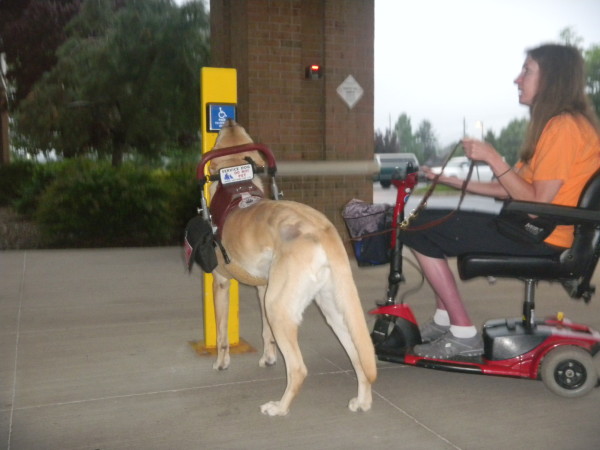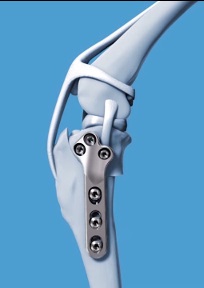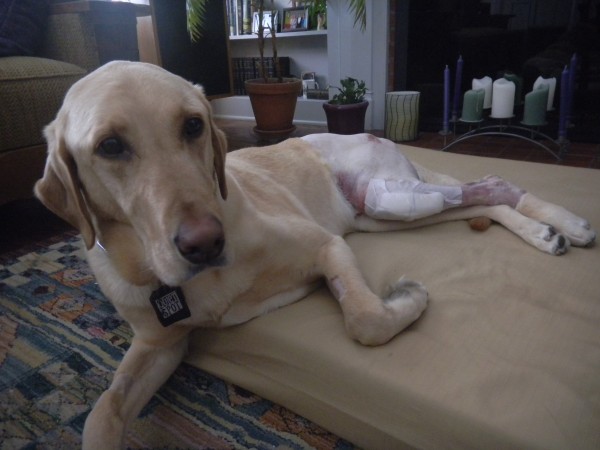The Journal of American Veterinary Medical Association estimates that more than 1 million dogs in the US undergo CrCL surgery each year and according to the American Academy of Orthopedic Surgeons that is about 10 times the number of ACL repairs performed on people. It can cost anywhere from $1500 to $4,000 to repair an CrCL injury in your dog.
A seven-year-old Labrador retriever named Maximillian (Max) was playfully fetching a ball in the back yard of his owner’s home when suddenly his athletic stride turned into a painful wobble. As he limped back to his owner, Brenda Mader, a retired elementary school teacher for children with special needs, he was holding his hind leg up and appeared to be in pain.

“He hadn’t fallen or tripped, so I wasn’t sure what had actually happened to him, but I was instantly worried — for both of us,” said Brenda, who has multiple sclerosis (MS) and has had Max, a highly-trained service and balance dog, by her side for the last five years. “When he’s down, I’m down. We’re a team and when one of us is hurting, the other one is too. He was in pain and just couldn’t put any pressure on his hind leg and this affected both of us.”
Max was diagnosed and treated for a “dog ACL” injury, or more precisely, a ruptured cranial cruciate ligament (CrCL), the human equivalent of an anterior cruciate ligament (ACL) injury.
Dr. Robert Rider, a veterinary surgeon at Metzger Animal Hospital in State College, Pennsylvania and the vet who treated Max, answered our questions about this debilitating injury and how you can help prevent it from happening to your dog.
Why are ACL injuries so common in dogs?
RR: At this point, it looks like that in a certain sub-set of dogs, the anatomy and biomechanics in the stifle joint are such that the cranial cruciate ligament is under too much stress. So we find that in these dogs, over time, the cruciate ligament tears little by little until it can no longer stabilize the joint and ruptures. Biopsies of the ruptured ligaments often show chronic degenerative changes rather than acute trauma. The high level of stress on the ligament coupled with high energy activity (fetch, agility, etc.) and poor body condition lead to a high incidence of ruptures.
Are there any breeds or types of dogs that are more at risk?
RR: Sporting breeds and working breeds (retrievers, Rottweilers, German Shepherds) are the most common, but we see ruptured cruciate ligaments in all breeds and mixed breeds.
What can owners do to minimize the risk of an ACL injury?
RR: The three things that we look at for prevention of joint injuries are:
- Thin body condition- extra fat is harmful to joints
- Good muscle mass – the more muscle mass a dog has the less the ligaments have to support the joint.
- Good nutritional support – This means a high quality diet as well as nutritional support for the joints like glucosamine, chondrin sulfate, and other supplements.
Of course any underlying disease process can adversely affect the joints and needs to be addressed.
What are the early warning signs that your dog’s ACL is injured?
RR: Usually the first sign of damage is limping in the affected limb. The limping may be periodic in nature or constant depending on the severity of the injury. They tend to sit abnormally with the affected limb out to the side or tucked under them (this is because the stifle is thickened and unable to flex completely).
What are the treatment options?
RR: There are a few treatment options:
- Conservative therapy- strengthening muscles and developing scar tissue around the joint using rehabilitation and braces
- Extra-capsular imbrication- placing implant surgically that replace the function of the cruciate ligament with artificial devices (nylon, orthofiber, fibertape, etc). Long term stability relies on scar tissue.
- Geometry altering procedures- surgical procedures that alter the proximal trial to eliminate the need for the cruciate ligament (TPLO, TTA). They rely on physics for long term stability.

I almost exclusively use the Synthes locking TPLO plate system on my surgeries because of the high quality and low complication rate. [This is the surgery that he performed on Max]
Anything that is “new” that is coming out in terms of treatment?
RR: The newest treatments are with regenerative medicine (stem cells, and PRP). They are using them to heal the ligaments in the case of partial tears and for improving function and speeding healing after surgery in the case of complete ruptures.
Wondering how Max is getting on?
Max’s TPLO surgery was successful.

Life before his CrCL injury included helping Brenda, whose in a wheelchair, get in and out of chairs, pick up items off the floor, load and unload laundry, exercise, push elevator buttons, turn on and off lights, and walk beside her power scooter on her frequent rides through the neighborhood.
Max also provided balance support to Brenda during her weekly physical therapy sessions.
After he was hurt, this all had to stop.
About two months after TPLO and some rehabilitation, including the use of an underwater treadmill, Max was back to doing everything he did before his injury, and more.
For more information, including questions about ACL surgery, FAQs, shared stories and how to find a vet near you who performs these surgeries, go to TPLOanswers.com.
About the Author
Based in Wilsonville, Ore., animal lover Kristina N. Lotz is a Certified Professional Dog Trainer – Knowledge Assessed (CPDT-KA) and a member of the Dog Writers Association of America. She is the founder of A Fairytail House. In her spare time, she trains and competes in a variety of performance events with her Shetland Sheepdogs and caters to her two rescue kitties. She smartly married a Veterinary Technician, who helps keep the fur kids happy and healthy, and provides a quick resource for articles.
